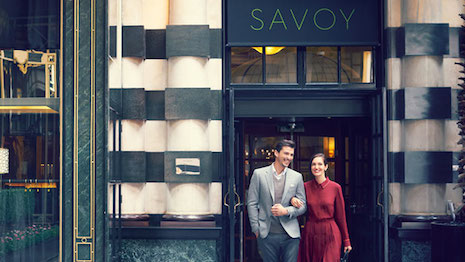LISBON, Portugal – Personal luxury goods are the most attractive sector for mergers and acquisitions, according to Deloitte.
Deloitte’s head of merger and acquisition advisory, speaking during the “Investment and Private Equity in the Fashion & Luxury World” session at FT’s Business of Luxury Summit May 16, shared new findings on M&A trends between 2015 and 2016, and looking forward to 2018. Forecasting the investment habits of luxury conglomerates and private equity underscores the health of the market.
"In 2016, there were several global economic and geographical trends that had significant impact on the fashion and luxury industry, such as the rise of commodity pricing, market stagnation and monetary policies," said Elio Milantoni, partner, head of M&A advisory at Deloitte.
When two become one
When examining global market trends, Deloitte hones its focus on three clusters. The first is Fashion and Luxury Business Performance.
Deloitte’s other two clusters are the M&A Deal Monitor and the Private Equity & Investor Survey.
Within Fashion and Luxury Business Performance is the personal goods category, the most attractive sector for mergers and acquisitions.
The CAGR of personal luxury goods is about 8 percent, while other luxury sectors are expected to see growth of 6 percent between 2015 and 2018.
Per Deloitte’s research, merger and acquisition deals by sector are most often brands in apparel and accessories, watches and jewelry and cosmetics and fragrance.
With 211 inked deals, the sector saw +62 PLG year-over-year for 2015-16.

Deloitte's Elio Milantoni sat for a portrait at FT Business of Luxury Summit May 16
In 2016, Deloitte found that there was an increase in North American and Asia Pacific mergers and acquisitions. For the year, North America saw 24 deals while the Asia Pacific region had 22 mergers or acquisitions.
For the North American market most of the deals were in apparel and accessories. Asia Pacific deals dealt mostly with watches and jewelry brands.
The hospitality industry is also a boisterous sector that has seen high-priced mergers.
For example, in the United States in September 2016, Marriott International acquired Starwood Hotels & Resorts, and all hotelier under its umbrella, such as St. Regis and W Hotels, for approximately $12.2 billion, a deal which formed the largest hotel conglomerate in the world (see story).
Also, in only a few short years, China’s Anbang Insurance Group Co. has purchased more than a dozen high-end hotels located in the United States (see story) and last July, AccorHotels finalized its acquisition of FRHI Hotels & Resorts, owner of the Fairmont, Raffles and Swissôtel brands, for $2.7 billion (see story).

Fairmont's The Savoy in London
Deloitte’s research also examines who is investing in fashion and luxury brands. In 2016, for instance, strategic investors made 68 percent of completed deals and financial investors inked 32 percent of merger and acquisitions.
Seventy-five percent of investors take a majority stake in a brand while only a quarter take a minority stake.
Sectors of success
After a relatively quiet 2016, mergers and acquisitions have picked up the pace this year, but is this environment a way to cope with the current luxury market going forward?
Commonly, larger conglomerates, such as Kering Group and LVMH, or private equity firms, purchase smaller, often family-owned, brands that have remained independent and may not have the resources to grow any further in terms of production or market reach. At Financial Times’s Business of Luxury Summit on May 15, panelists during the “Europe’s Next Big Deals” session discussed what has driven merger and acquisition in the luxury space (see story).
Deloitte’s research, now in its second year, also forecasts the expected investment trends for 2017 by sector attractiveness.
In order of attraction, Deloitte considers apparel and accessories, cosmetics and fragrance, selective retailer, furniture, watches and jewelry and digital luxury as viable investment options.
Sectors with expected performance growth are cosmetics and fragrance and digital luxury.
Per Deloitte, the cosmetics and fragrance sector is forecasted to grow by 1 percent by the end of the year. Mr. Milantoni’s noted that South Korean beauty is subcategory for investors to watch.
For example, beauty marketer Estée Lauder Cos. strengthened its presence in South Korea by purchasing an interest in Have & Be Co. Ltd in 2015.
The deal brought Estée Lauder closer to skincare brands Dr. Jart+ and Do The Right Thing, popular South Korean personal care brands. The purchase helped the company increase its presence in Asia and capitalize on a growing South Korean beauty wave ahead of a potential global flourish.
Skincare, cosmetics and beauty products are especially popular among South Korean audiences, and the country is seen as a trendsetter in the industry. Thanks to its new partners, Estée Lauder has an opportunity to be associated with that trendsetting (see story).
Most promising is digital luxury, which Deloitte expects to see an 18 percent in performance growth.
"Apparel and accessories remains the main target for the investors, then the cosmetics sectors," Deloitte’s Mr. Milantoni said.
"Target investors such as those interested in digital luxury are attracted to digitalization and innovation," he said. "[Deloitte’s data] shows potential for future investment."
{"ct":"81O+DnlTuF8UOLxDdv26PDNgr5\/563wacSkmOQ2FxisSMhVYt92q9WSSBqj4ZraHqzugvS3lxBGio0Xr1nnanlwZeutPT2sdvaPmEH3z4pKPKMgM2\/a2RQn9EF753BUH\/o5dKIEl+XREeBe3dKSJ3xSBKCASs6B52xP1zGoxafr+XzRvx3Hzrk9vzwA9O1g4vRyvA70e5TfwDf07PCKzj1+M2DTtgnLd9TDz5BsBdlOvNF2bhnCD3qBhCzFFqwiYF97qFJGd8jEFHZdCe+r9PF46rqC3qKzfoca1JVWxG\/t3Y+UIf71ZiyT+l2bVHhrtyGbGPUysng3jkvGDs8OLJ8FY0flCx+wCXAQdBnrLOmCOJlKmnMnks6wMG+Aa4WrJcn0kra5\/Iv3rC+52Voj+3osJtS0QRWKZK+bMupTL99befkcEqlV7CoVyErwgKcOC04SDnhihpSTGeZ1Ulzr+NsYEUlpWsOBN20WF3X4vgTIAs60P+9ZkbwAIJr59qPJoScOwZOreEFX3XZOCwvlKVloAeRBjXRVQVih2PcA+ioTxF0cf3AKEj68aJSOPD3AvbJmMVaeLsf\/zYeykdxf3Gh4tkrB8IAtRnzCXtwrfXWhghQySpfhcS\/w\/P6c3syPkUjYmyVgJVLrdYXh21IsO6gvvUKH1w\/rqIObk87fgnaffdRLsX92zB0U0UYze66EdWBJSaRY2JEgynQNe7FF4WypVBbw7k\/XvimoQcw+ZPt\/XI1c7R2\/eTKzYhtMoFjuhaj7XZlCPqZQ0mipa\/QT92K38GTwp5mkYoOKd0CT5pwDrbomLZPTYLoYVwjixW0by8iY6j\/fJKSsiXFelAmKNwqsm9teW1REXMcm7QrSE+zuNoZT2eyIH\/J3fGEIAx55qfuaweschGFSeF9\/T5DFEv+OKKFWZcKOsAb4J7Ur9iLNBFmkCdiweAhRXyWuOm\/OC+FQGeUi0RexI8pta\/PH46rlhgCVDBRPU4RdqQ79mWmbCSw3BT3p5OCtXGywYCcY18DYbWbWb\/Vkd8coHBpMMcDwMX0EwzC1HEDBYG7cjJBMqDgSirNn11z9fAm\/SWVUc+JXD6PnnayTWfIo9ICUolNypvZT0jRkLZn\/YblIe\/VkkDM9nAee5DOiy4san3kXR12SCO4H9sWc2Mp8Pd78pcpSTfM6J6URNBESmWY9OpDJ1IPC9CFqEWKogza4VqzuaPj65Ak7jqMRXWEPIXBLpdcUDl3X9gHvXf+3\/Lw1w\/k7kF1R0752G+O\/6OdkYETzzSr9i\/bpAdR0ShjLuOnq\/nVCxYbG+9o0aBRSMX3Fe8K9OZVZXlM66TuIW2+35NNos9j9gBqv\/IS\/zi31pU\/\/C4I7uL7ZdWdrXKjY80wjqr43faw7C2Vq29iIR3F0EMBjPdCeIa1R2DPQ\/NviuQV1Jon4p0HLaPjRWx2kdfrFdNtzTCu9z8J0iHdMVfD96rbRYKJ9y68dEhFaoPaoIz408xv8GSvLyM4i\/P75\/\/yzMd7lsZmV\/7ySt9blCYB7OCw\/Z3UQyS\/HLBvDFzJ54+Pyf9zNDRJPYeFZMH78YYoNNSC8tfqDKCwikhBX00V0nhJ5\/DIrnHXXrHdQ4cjmzjXEOqtWOMumsCRWlNfd\/TRD0TTfOZGl5EhJfnxehsNXIz9Gj\/WbGTXjpLNUAnDEiFHuErJ\/W\/9dNAYHAIdXbM6tIgoZBJKvs6UHNPjRfLVT7\/YUpLC3AMgMicDyRMWqYNio21WbNOrAABhaMfqV8gKbM1Qz2Ll1AktbtInLco116XmPPZp7M0kKuI5tW0ExqP5QRfxafUttQmMWjYlrsicfE2rPbyE4G6JZfLR9mYh7gnBSW3XwfI5o1COQ6Lm4\/1Ao\/qFu+7NQA\/DMiecobei30Sxu8lwNpKYHYHJux66CM7VJpi63WfEiOZcG+Xs6dL5Dru7IHhJ\/hbftDjTCfqrTEepwresk5w4eGdyzE1A2UyXRud6Y06wjTrjuzG2csZvJWJKsEE+QiZUMRJYI7T2DII4bHBtRNAel1NNuiy5vMCDzeJa1MzmD3UX\/toBGY5HlXJR4\/fXGbh+F7hIiSq\/opmwMM5vbckckpMAwC1Iax3\/aGgXEoc2n12fqGqZL3yHOXpAXttjeN83BHHnvfC7PsDupDPZjCGQJsxMRf4oOrshaYybTZeD\/KaJ3Vi73yPOdEYxCtA\/kEyjnW95Ync5hrtQRr\/BXWTyMpelwgkpU6\/jmiqk\/T563k6f3ICfWHydWVqSPH1c5HqZNPuB8+M4XXBHQq687lfV6SX\/AJHQSb1RYnef6UcA6r3T8DYkFZMqHtiRDUcRV5FysBQGwYTva6FkAHQDbuqh+9Wpn08RV9Smhz6zu47Ai+gJBW70Y3nwKeR8hWLP4N19HfBstWgwkexjaG6bg6h20l1nZDR8qgJK4OMrtTjPsNXotQkm\/EG\/uSHzSLDFqaKmAUdZZ+CMnCEojQIhKk5IaJv9K7\/I\/9e+DOiU0vDd4rXg6fuqZcWCN0Xw6qnrp1zY\/wRpJn+F5GRKCCuNYOaE6pqBG8Jq1xt\/3ySDSKWYefzQ1AsUYXL8pnQI0T8jVhxP9s0zA6iRWSmoHlNP21Uo7THxPXJjCgEysRfuqmdw28mRHyBDp14+E1TMn8iNXifhgPimRoj7mfOquH7t9umXuJrdZInqyyeJiA93d4L77\/sCrEUc4ViDOM1nBc59D21JEX98KJBN+lEuDN2X92rjzHQ7WIj3bScmCTLGfxoPjyYcI6PeFb9soZyBUJVilPrG95mRhWuwX+YU\/JxqYWfCcnvHh5SSsT81i7oYHaiCUAVGcolA8lSIEguz6Jedbxa\/SkUjvvAtD1orDtzE1CiIZJmEGxxDCnwm7OpvXxlLnLzjVQl66ITZuqrhR2YvEFGY2J9xOiH8a10ECCmogm3aX\/qVmmYFroG0TaVPIoSwpHoqEBHK4uYcVaKd5dsk3CSag4+XLBOpoGz00pQjRMB56c+2n2uH64o5K7U3XB93B7Bp2yK4Zv8oSXMO2wLspX0MQdOPDOfm\/HrODgetJjQ3e3qIHgBAGr3cOyitktKD6cQ6TXz5T+kXkvSdnIHdNCwEwsexBjJ82eTXXHMmTZy\/tFgnRE0zBwX0k7YCT+KFN7GrTUmY9Kv7J3Mh970l2FOp1eF69LBvqV6nuWqoo4NxPjN464wnFcE4GWV+YIvReyBehSUoE8VvNbUSZtfE+mn\/L8eRxziA4aDw9mp7Ee0m37fF+UVSib+36wKGJ4YM7jMV4Bo0sEgyCI2r8rlJPk5939rd0JaZvnHoOva7Gi2ObQPVVkLSUVW5xxJs6wfSnhRUw6XK1NjRmhOYvGSOs02OfMLgtFYU6aqeaIlRQbQ2z20+zCu0v+SkmnXCebvaW1RE1jxvqmiF8GVRIfrs0jmFwxJwMchz921Bu45J2LTQhfSYINjYQi5aP0f9zAaPXxvNtsmoKwN8m3aoqR3zSj6qONF6mGe2Ky\/+L7DTG9pYJZcnN9AIwXjH\/JosQOk3zx+KHNbyWAtbw4pd2CpT7CPZ2yF30b2nWm1fXcz2PUhmrsOeFKIBCPgjMCCVvQVhlWARHcIaaFttC13tIaEG\/DRRHvm2j0UZzbpKjUlTRZdrLECS0iTASAJ5kAMYicE6cCJ+Y2Nd2kJKSjfwDmt2OYL3kT25jYLbkuVWNWKO0zfTHi9W8m9ocl579oRH41TXTxAnpJaT98Z1U7x3K1Vx5e7kWnKJZR56w1j+TWd\/CxIFZDk5VGytmCkPg2NbQA0uteugGwKIg0\/eGwqZv21pe430U509Hv16xB0tWi5mZCO9XEBGU0gcB3cti25KtdwVWtmVO93jdfnlKuulRLf\/KDBxoTb5K0rHdzxzcDTQ+5zWoHVs6PjJjG4Bd2482F42izj459NMLXNOmUtZ0Fvd7QxUDxuEsO2TLUnzEl1jWWLrTPWJ4Md1ESWPNKchEyis4NAuYHjL\/YoGT8sE2VgXyBCcvJtcMBBWPaIMXQAsFmU7AubYyBwFrKx79etc+Iq6Ecq5yo5aoT0mDvvpB56ZJQ+FejiiObIoHwlx7H2ko2OHBefF7fyGrP0x4ZduULYFT9BR+PfJI+Fgol16di8qYuGQIZrnVq08Tf+M616J+CC3PqsH029gnphitf24ApZVoMkuIpZkQoIxcmK8uE2bvwZKtHEuxIFco9ZTlVLILg3IvqH9QVfiC69DRxvm0\/D\/XWBbMr1oz2Ds5fuvNLWybmra1afYZ9XeKZ0fLGasqf2McY602BHjaf\/zWr\/l0ytmeCNLQ9InRfCsTG\/Rzs1DTqPqjGySX3ABZPtMeexVuSe6TFpmh7OPuU2UYCL2HxYJ4sRDwZq+VMadYaTtbDo2t0Z+ldSzGTnhX1o7iGcNBPG\/uUqVrh3y7HuI8ge96TGsopRBXspyut4FyiL6gfDh0IvB2F9CVpmJzXWtzVp2PmT2PZkelUoXFSWe8hUMQFBVfRL3NGe13RCj\/78rfLPfpJtls21Q+5s3DwLPRMd1WhWeXcp6nXbtIpc7omtYVJgfVlVW\/FFUsFa3bY4OyLP52BhCviZs0YUAYIZqfeT+FIi53sEiChooDkzNNg20Sqi93uwP504lM1fuwz81X\/yaTGQSE28c6OQrHZyXXOXwEOeTwYTaSUX7BB\/pEe1yUA0Eh\/pclEHiZA5BZmjzyETlW9LlYvknlFE5vs5HZCcsK9GCzVvL2vFmjEWBLu56gbAO5J9igWQG8BjNA8X+xptld\/7OS5g7VUZNI6M54Obe\/456vyYxj9MfPAJk80ovi1P3mLUOqcXVhnGUG436QDCknMnq5ok5baDXffRG9DKKpDT3VyTWfC1e19NccNudsAJPrBUO9jRmOjQ6ek2wMSM5Dv+9Dcogzpz7Im\/a3j5NIZZ4t8WXD33SwIWGyVpjaYLm7A3YH73PxHUe1I5OIEYr5LAYRORaNTTY5j6\/hQZJbElSnsKJlyazrecZyWoOxswzMLfO44XaNQRfKpDHxe7EDKt3Aa4KK0cEr0entPXoZEJw4FNxWXfrgK4VoX9zx+Ey6dMhmeK\/asSv7sjWsM1OOeTMfmTgzOyXkGK2fnx1MdyZFTz9WR8de7D4DwjYBFCdniYqkAxh57jo8+OkZayaGT6hDX7p1XJfZT5KN3gW\/XTIW3mMdncyXIdkR6uXv8NaJlffjd5KEZ2vnFMe9\/wVYLctYwz0NdbqFKffQDHp5ag2DsMhgPKM\/+YDAvPjgvKZmYFsbmFiF5WL+a\/gbyUg8boSbz8iUvVk70hzYYzDpKYPT1dbNl\/J3WTH+eecXDjk72Tp4wK2C2sIkK7Iv9izfB5bB9fhWaTlSdqFizDK0pmOYq2frVFo0TfvLZCyfLcYjs10hF7LAr0CgPeQTVADfA3P7+HvZdaeqM\/dgPBgsLz9flQJLF9pL6+VLeobVX9QNFK7kCZAmvN1am3Sysk\/YDFL09iySlZrf+q1zm\/zjLTChnBP1VO7woyweCq99AGn8dPtkprZDZvqYC24y5bilPJZfqKAlKzAmQgQJ3EdWc8\/3H98xheVfZVg54043wRIweKltM8Opl\/a9YGmHIKRsrfq5IMtm+22umO\/jd2IAJORSF9JZPnU8lXmHHps4etSSlwvFkV2lmdCMvVOl+eN+sIUdGGPPx\/jLClyZY+DoETbQD6lvDcVwOLtDkXNKdpH19CutW3KONy94xN3SyT+B+xZItcaPRkZrDfLY\/fNpynP4dE1\/dYkK8QbquzGcUsDTOCJBQl+EXbdJp3+MOX+UVe22Pb5abZnMlGpPHU278WYFwbFkS822UKRNfY+y8vqHa49S7QgDMSzJK2auJfsJ2Zd1pbzyl3nfO+c7JuT22YG32iQ6boX70ok81HWF2NlluAB8shAFOoGQxON6+DYLT\/fokkza2o6I\/QqWKdZ15Ul9xlno18zW6+n\/8qe0j4j\/FRSmlNbVgjiOuxFvHgoWw4yMcl1b0Tpb4RT6OQGz87hPqy74WSGVKsB6Lm1j5w8psg1WKpCx4098QEku3lbP+UV++pm5u1ZXkvrwT4hs3X0xwqP7Yuhq9H0nCk7FjiOzBOu6enF\/9yoN8O79xmqRUC6zPZd4Q2IP4b6C56JbLB5Bf2Yk6tVft0l49EzgHBuc+CUKQzGWIGHMuIiLnwGzVCU03lgSwElnbMML+o48out3w505x7C45ILKQRxFMui2OdInl\/LIv6BVeI\/2nuSMXlAZjcnYF2fL+iYcggPI1DoFF2tuWLZC\/sHBQixQBVYrSl78DIqncg2zuMh4TqR+q7QlJKOBr1EaBlz3Ss7UHxMRUKOsWFsIge5I5JfQ4Sbq0lwva9+9eG39u97HtYNJpOIBRcr4U2vuCMIDXPzQGbCaxgvIMJzS7uzVJzJXTqPf5MB9HZYNMIe01oQ89z6+bQ1hnsoHYUxTEBE6TrvCsWtXOGz23+8srVX7COubHGZ4hlWagoFxJpSS1qxcfXc4TYvJV3E+WBYdQto5jcdYr5Yd753HmvCE7CXEicvwjwplpnPllUvvAHysIN7EsqD5csVdHMJflOlI1wK5rpklCVq\/OITcjWJZZc+2QlY5BaTCueiP6ZHtIBiSQddOZZTuZnMb6HnEiHrW4m0RbT1BEzGUMzxZ3QDdxWwNxLUgaFgZf6VHcwYOicMwdeXBXJcsHg5jwUbd3rye9UMWXVUgTs6vlY5jLs\/Adic5\/BFlyWULYMNVu8wFcD8du6pKtelTMDNv2IjBEkqKdx6xr1C\/GTYvB6H7zOhFM1OqALYxlqi5uMOdwyVAv9wTVarrWCf7g9m5cHbag5IIWIdbw+Q7stT0ZbWSASeehMIB2NMt49ADrJbLFDGPv0vIapDoiVIBiepQCwkRuc\/+zQyzexA9RA7xKS\/yvmN8aRB5rSUC6XQ+3ZYdL4HqM8V1COpXMzPEwaUwyGjXBWOLh9UQyt7KJ4oTe2MilluY\/J8skNkRvKkekrtrIBdtb7cgylwoJhlqirDD9pFviMnl1ItAoyhFiPgzR80we45eWWrKk3V040nslKlfPTBc39rE3zW2lshbEi+18kPwmzvOeaWrnx2bYemf5U0j0+nPSu2pZDE5SsPjGXAh00Df6UNLB9k6JPw+zxsiFplRNRDOuDyTejSWqgPXaYAQobq8qN6dQqbNzlwTqN\/+oi3PptRRU8c4tSkcoiR7vwY0qcAwy9belb5bdTlUEXjnWyNkpA4J7kSdily9KNQDNQonv2wwUL8C2QIpg1GLg1tlDtTacoeOzzq\/0kBepz1tlpYOxdCOhMgSfZVt\/d8QEmVMGXDinZy8sS0mmgP4vYWKyHgQPX6xDVgsKhGexKmcO+DKpMQY6lptAeUvjUUGdqIEm4cb+9bZWC\/Lmg9GLl5kbYorajls6Aoz\/qF0mx9n5CzXG71mQNvRIYu96D0QP\/ACmV4D2MtmVLm\/KeAEQvu\/OuamuEKQCfBsiCj59XQYp8oOar40FFhlCwLDRf3sxBxfSxc\/IOigEagcBFMJ9QFgJrLGAgyp2Q+\/LHkD6kDnTZ0u5xBYuu0Du28L4dmPq+68DHvk1NyA0c9pqgLg9JLQKOg\/dsPTc4vuau89edEgihI2iNHxN3CwIYkt5ZkeAHIyvYjCVXeXiSR5cmkrZa4xYdl8HjYfed31q341JfTsVaGPSab+lYRPpeK8M1yuZcocSdzGHm9wV50nxea2r1qHXibGyt0PqARXJ21pUv9Wj80DCQhyajBB52EcQic\/obroP6NKNNCa2bzpqpXLNtxw9i905FPGnLgBiJ0FgqzjM8cVjR+Ezn0FSfYZC\/x0h2MoqZS3luqhxKd7ScKOf7UON4+3LOFk\/YJAMMoarkoXNnlDSmEGIESmousbQqKC47vtflG2xJVs9Z0\/r+BEXefI\/PV95YxfUIbKptjwD71rncit+E8wRPKcexe3+gfn\/nsjKN68wXoa4tSKxcfyqD\/s4momFX+U+yuhAkOj84vU9IrOEgq7V+B9IMeuZtEH2\/2a2v5QDW7Oh\/JvCA3Y+48WbA\/vMeY\/CGTPszgUlDIhQQgcnr14eT4gcRZscGQjGMozLk4SibkqANW6cqrE9Oykv7PNRsPcJ4cRruhtapqo0s4qPU0ciLnFwfpWWIuc9WDT20diB+gnceuQgVTVACsKWPzNJx0edwnpDKGv2eqKlw5gVrP9IOipCa0kHGM0L+ix9KbWLJTdbUNkg4IIJ5h7EbZGkl+x5wnY\/dIUHdCI5bXeovIJ2jh\/95j+3bCl+eYuQJskdrsDPN5s3bj117h+rPs5t8hH4t\/f6NYHxCWo8LEvJlwCEZ6gND\/1iYG1tR5mwZ3+m8hkb1GCRp\/\/uvC\/NmwwthG35lJE6xx5ys0Q9ZIJjOMolmSjpsDSSnvhdUNLc8OfBDK5n5UK71rE\/jPh74CvsqYX3mSIbXHRruQmp9bN\/CYegYoyyX6bJHI9xjyBDb+vyJ9SMpMcGLLqgGd5s3q9TURD8ZQTd1Hxi4g827TMb3QvpDOJZOamXDYPGpcKJVHEbDAJU2wWqWoEi5dGD+lk68e+u0U5zn7ge4ZCHTlOpD5OrcB4d17HSQsJrMJ2j\/xLnaeFj0dxnblaleFzLE+kv59DZjevlyFRgTRsPyspiGtFgM4tjGLS8wAzXG5pK0ckoYT7Qp1\/LuaEutZG1lo3KtWcIBK929gPt8BNKbPqmbqmAevLT2yfhn\/kt\/74dzk\/kWSd18QIFUI69yxnWcrNXZB+XAw0p9elYGBm5jGTXFnDwVNjaEQMh5CvYPq6IPBGcV\/G8dvRIoNtBdGKz3+mb+Ssqti4eWjmTSKlp0TFqP0774ESKiDVPFt+AsnQRr1yYFaWW0e4eUG723v\/mj5Oj6ulwPXzZos4xqe7aZnoTZ+TMfdiIxpAylTzEKHO18lqwRvMrCUZQDzUFeUG89i4f4WG30fIKoTk7sz0FmuGOp9PuwifWzpRsFsYlFwLMW2EnYq1QrH9uad6JBEgeiOyCKt+uZzwjE5\/+Q\/q2uD79O1yIPGBjNzyzvjImxuNXaHNJQn1R01phGw6b3tRdfUixeS4fdlPya2FvwTG7qSFWT9rNsqssaaSc36qQU6Nzy0tQDIrFd7sOElE6X4QZmo5NMlX70nRbCFfaGONeCN+BVL9NFpkx0huqtrpBBGD9CWU4cojMmzHBZCSCW7jT3NWXGhJbVzimqlFD8XGASw42FW6ejzbkpR3hO908ON3yars54cS7xT0e9aMI7IOkcsXOoUnJVqLRVZ+oiYXI6eNo6R4wBegNIv3TJPJ7Exicu6a2U3ZJfqgqavF8+o+gLnSBc3zHE4+wRYn2sN\/FgLGPKhD50dhzznOkoW0mj1yarTtg51p1ZqUMOMhVdjRA+OtHADoKUhuTgFlNBp+QnSdWLU22GJxn8zRuX6aWYMHhMBW3WrwWYZ2+vfqvhvgaA95yOMyD4nxEyunmU9kmdYmnzbL4YRm4E1w5QviKFysqMp\/pWNO5tuwiLbx\/MIa4l2fK7BBKewcHF5TlseE8h2JkhRSYYU92keWw32\/V6cfzaVo2iPUuNGTcy3HxO8ac19JkCtfJVvwiL9H5ZtVrnUBvzyraPsDoKLzVbC2R\/cO1tyqySMTVNoRInHMNhZYxyqnFZutHeTR2waehOj1XPTPAu9Bt3jJ3tq0WW\/AQa0qdEaTqbTphwzrI0vM1mE4Ms6OZLJvJb79RMKXnfAiXnPRrRTbl1seHQtIxoIYYcSW4vClbMvFRCab2rQLUclrlN3K3WJOd\/m+vuWtpICxMViuHbtGOE65ek97tR8QEi97oC9ZKb3DQxNPOAqLgX7YKlsNzandDMJZZCzsOVdfzL7Ak+QoW","iv":"f0d9f3b7db7ae2623df23fb522043313","s":"94e75df677a483ab"}

 Estée Lauder Cos. has had a number of high-profile, strategic mergers & acquisitions in recent years
Estée Lauder Cos. has had a number of high-profile, strategic mergers & acquisitions in recent years